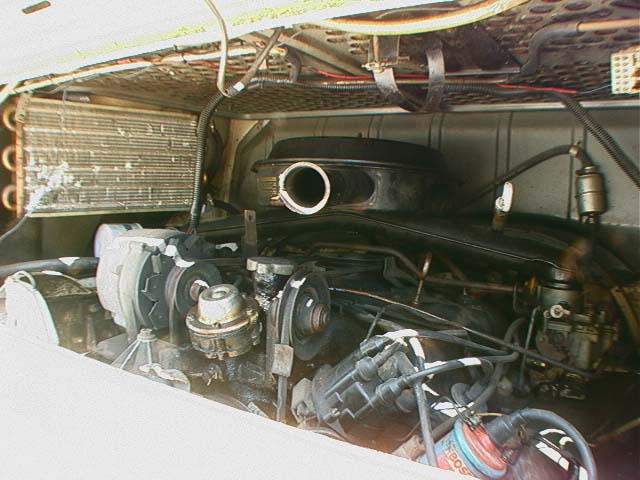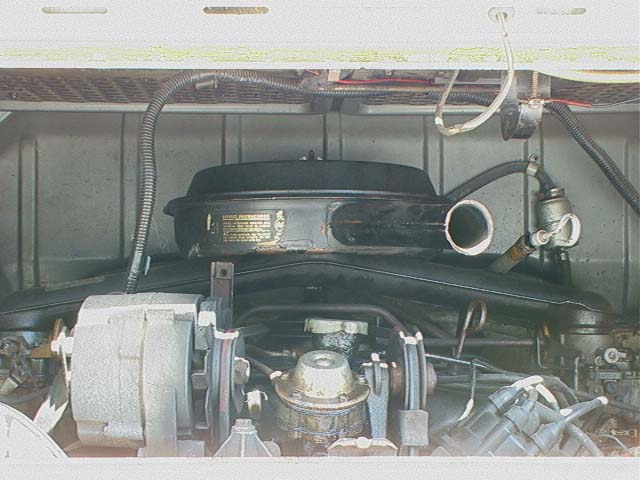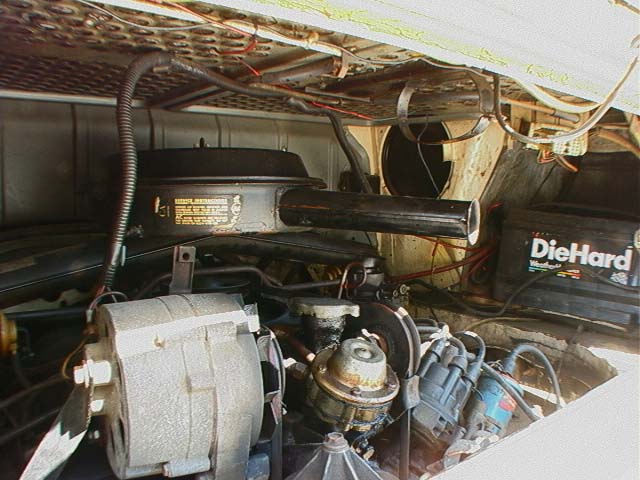
This bus spent its life in the Northwest US until it was purchased in Seattle, Washington and was driven to Champaign, Illinois in the Fall of 2000. The engine was replaced that Fall, and it was stored over the winter. So, IT HAS NEVER BEEN DRIVEN IN SALT AND SNOW!
Little is known of its previous owners except that they took pretty good care of this bus. They had installed a Corvair engine and transmission (and aftermarket tachometer), as well as repainting and re-upholstering the van. The camper tent marterial is also new. They removed the sink, which is long gone, but the water hook-ups are still there. The interior is in good shape, except some marks on the dash around the radio apparently from the enlarging of the hole, and a missing cigarette lighter. There are no cracks in the dash nor any cuts or tears in the upholstery.
The paint still shines up nice, but has a few miscellaneous dings, chips and scratches from being well-loved. THERE IS NO MAJOR RUST ANYWHERE ON THIS BUS! There are a couple small rust spots where the paint is chiped or cracked, all easily fixed. There are no rust bubbles, nor any rust on the underside. The tires still have more than half their life ahead of them. All the chrome is in good to excellent shape. There are a couple of small chips in the windscreen, but nothing serious. A taillight lens and a turnsignal lens are each slightly cracked.
Unfortunately, the Chevy Corvair engine it had in it was only firing on four cylinders, but it still made it over the mountains! So I went to a place near Chicago called the Vair Shop and listened to a few good motors and picked the best, from a '68 Corvair Monza with only 32K original miles! The engine has been fully tested and inspected and shows strong compression on all 6 cylinders!



Some VW fans don't seem to know much about Corvair's, which was Chevy's attempt to compete with Volkswagen. In addition to the cars, they made Corvair vans and pick-ups. Basically, the Corvair engine is an air-cooled 6-cylinder engine designed be in the rear of the vehicle. This means that the only necessary modifications to install this engine in a VW bus are some mounting brackets! Oh, and you have to cut some of the steel dust skirt off from around the Corvair engine. Also, the Corvair is far more solid and reliable than VW engine designs from those years. In part this has to do with the amount of steel, rather than aluminum, in the Chevy engine, but also in its bullet-proof design. These engines are so reliable, they are the #1 choice for homemade aircraft builders! And parts and mechnics are pretty easy to come by as well.
The original transmission in this bus was a manual, and you can still see where the clutch and shifter used to be. Whoever did the conversion used the standard floor-mounted shifter from the Corvair, and mounted this just below the dash next to the steering column. This is effective and convenient. There aren't many automatic VW buses out there, primarily since they are so horribly underpowered that there's no choice but a manual transmission. The power and the automatic make this a great bus for cruising around town, or the highway!
As you can see in the photos, the first Corvair engine had an auxillary oil cooling radiator mounted on the left side. This is unnecessary since the VW bus already gets more air flow than the typical Corvair. It's still in there, though, so if you plan on cruising through Death Valley in August, you can reconnect it yourself.
Extra parts saved from the old engine include: spare pair of carburators, distributer, alternator, and other misc bits.